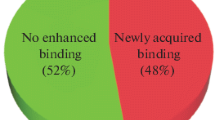Abstract
In half of the sera from patients with acute bacterial infections and 15% of the sera from patients with acute viral infections glycoproteins were found that form a scalariform pattern in the cationic range upon isoelectric focusing. The cationic glycoproteins appeared with the clinical illness. After subsidence of the symptoms they disappeared within 4 to 6 weeks. The proteins were identified as immunoglobulin G (IgG) by determination of the NH2-terminal amino acid sequence. Remarkably, these IgG only contained light chains of the kappa type with high proportions of carbohydrates. Both, N-glycosidic- and O-glycosidic-bound glycans were present. The glycosylated light chains may render the cationic IgG multireactive. Thus, it may be part of an early nonspecific immune defense mechanism.
Similar content being viewed by others
Abbreviations
- aa:
-
amino acid
- IEF:
-
isoelectric focusing
- IgG:
-
immunoglobulin G
- Ig/H:
-
immunoglobulin heavy chain
- Ig/L:
-
immunoglobulin light chain
- M r :
-
relative molecular mass
- PAGE:
-
polyacrylamide gelelectrophoresis
- PBS:
-
phosphate-buffered saline
- PVDF:
-
polyvinylidenedifluoride
- SDS:
-
sodium dodecylsulfate
References
Abel CA, Spiegelberg HL, Grey HM (1968) The carbohydrate content of fragments and polypeptide chains of human γ-G-myeloma proteins of different heavy chain subclasses. Biochemistry 7:1271–1278
Allen RC (1980) Rapid isoelectric focusing and detection of nanogram amounts of proteins from body tissues and fluids. Electrophoresis 1:32–37
Baenzinger JU (1984) The oligosaccharides of plasma glycoproteins. Synthesis, structure and function. In: Putnam FW (ed) The plasma proteins, 2nd edn, Academic Press, New York vol 4 pp 271–315
Borel IM, Gentile T, Angelucci J, Margni RA, Bionaghi RA (1989) Asymmetrically glycosylated IgG isolated from non-imune human sera. Biochim Biophys Acta 990:162–164
Bowen B, Steinberg J, Laemmli UK, Weintraub H (1980) The detection of DNA-binding proteins by protein blotting. Nucleic Acids Res 8:1–3
Drickamer K (1989) Multiple subfamilies of carbohydrate recognition domains in animal lectins. Ciba Found Symp 145:45–61 John Wiley & Sons, Chichester
Gültekin H, Heermann KH (1988) The use of polyvinylidene-difluoride membranes as a general blotting matrix. Anal Biochem 172:320–329
Haselbeck A, Hösel W (1990) Description and application of an immunological detection system for analyzing glycoproteins on blots. Glycoconjugate J 7:63–74
Haupt H (1990) Chemistry and clinical importance of human plasma proteins. Behring Inst Res Commun 86:1–66
Hewick RM, Hunkapillar MW, Hood LE, Dreyer WJ (1981) A gas-liquid solid-phase peptide sequenator. J Biol Chem 256:7990–7997
Heermann KH, Gültekin H, Gerlich W (1988) Protein blotting: techniques and application in virus hepatitis research. Ric Clin Lab 18:193–221
Jacobs E, Clad A (1986) Electroelution of fixed and stained membrane proteins from preparative sodium dodecyl sulfate-polyacrylamide gels into membrane trap. Anal Biochem 154:583–589
Kontiola A, Maury CPJ, Teppo AM, Viitala J, Järnefelt J (1987) Glycosylation pattern of kappa light chains in massive cutaneous hyalinosis. Glycoconjugate J 4:297–305
Leoni J, Labeta MO, Margni RA (1986) The asymmetric IgG non-precipitating antibody. Localization of the oligosaccharide involved by concanavalin A interaction. Mol Immunol 23:1397–1400
Mäder M, Retzlaff K, Felgenhauer K (1992) A cationic glycoprotein pattern in human serum and cerebrospinal fluid with pathological implications. Eur J Clin Chem Clin Biochem 29:481–485
Maurer RH (1971) Disc electrophoresis and related techniques of polyacrylamid gel electrophoresis. Walter de Gruyter, Berlin
Michel C, Gonzalez R, Bonjour E, Avrameas S (1990) A concurrent increasing of natural antibodies and enhancement of resistance of furunculosis in rainbow trout. Ann Rech Vet 21:211–218
Montreuil J, Bouquelet S, Debray H, Fournet B, Spik G, Strecker G (1986) Glycoproteins. In: Chaplin MF, Kennedy JF (eds) Carbohydrate analysis, a practical approach. IRL press, Oxford, pp 143–204
Navin TR, Krug EC, Pearson RD (1989) Effect of immunoglobulin M from normal human serum on Leishmania donovani promastigote agglutination, complement-mediated killing, and phagocytosis by human monocytes. Infect Immun 57:1343–1346
Neuhoff V, Philipp K, Zimmer HG, Mesecke S (1979) A simple, versatile, sensitive and volume-independend method for quantitative protein determination which is independent of other external influences. Hoppe-Seyler's Z Physiol Chem 360:1657–1670
Parekh R, Isenberg D, Rook G, Roitt I, Dwek RA, Rademacher TW (1989) A comparative analysis of disease-associated changes in the galactosylation of serum IgG. J Autoimmun 2:101–104
Savvidou G, Klein M, Horne C, Hofmann T, Dorrington KJ (1981) A monoclonal immunoglobulin G1 in which some molecules possess glycosylated light chains-I. Site of glycosylation. Mol Immunol 18:793–805
Schipper HI, Kruse H, Reiber H (1984) Silver staining of oligoclonal immunoglobulin G subfractions in cerebrospinal fluid after IEF in thin-layer polyacrylamide gels. Sci Tools 31:5–6
Schur PH (1972) Human gamma G subclasses. Prog Clin Immunol 1:71–104
Schwick HG, Haupt H (1986) Properties of acute proteins of human plasma. Behring Inst Res commun 80:1–10
Sox HC, Hood L (1970) Attachment of carbohydrate to the variable region of myeloma immunoglobulin light chains. Proc Nat Acad Sci USA 66:975–982
Spiegelberg HL, Abel CA, Fishkin BG, Grey HM (1970) Localization of the carbohydrate within the variable region of light and heavy chains of human γG myeloma proteins. Biochemistry 9:4217–4223
Sternberg JC (1977) A rate nephelometer for measuring specific proteins by immunoprecipitin. Clin Chem 23:1456–1464
Sutton BJ, Phillips DC (1983) The three-dimensional structure of the carbohydrate within the Fc fragment of immunoglobulin G. Biochem Soc Trans 11:130–132
Author information
Authors and Affiliations
Rights and permissions
About this article
Cite this article
Ritter, K., Wiebusch, A., Mäder, M. et al. Cationic glycoproteins in sera of patients with acute infections identified as kappa light chain glycosylated IgG. Med Microbiol Immunol 182, 107–117 (1993). https://doi.org/10.1007/BF00190263
Received:
Issue Date:
DOI: https://doi.org/10.1007/BF00190263




